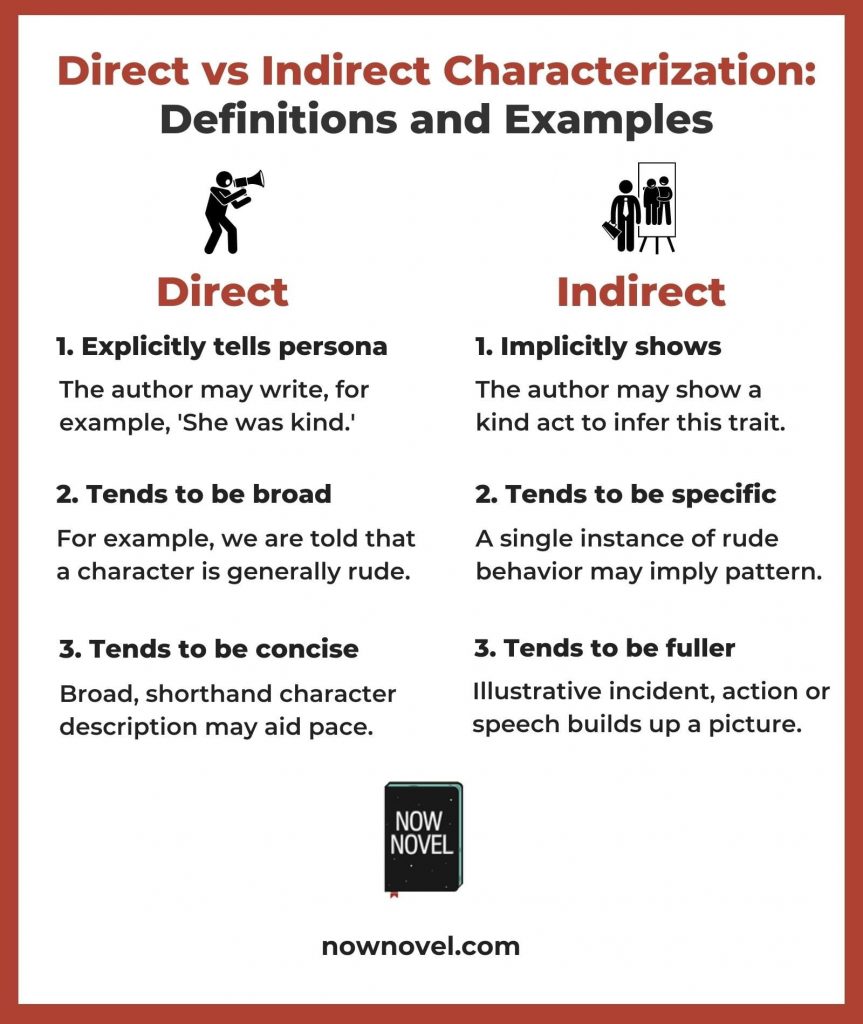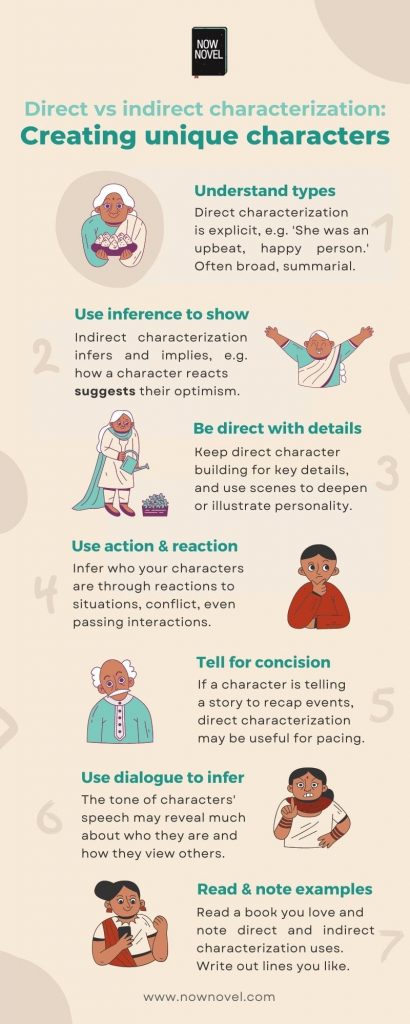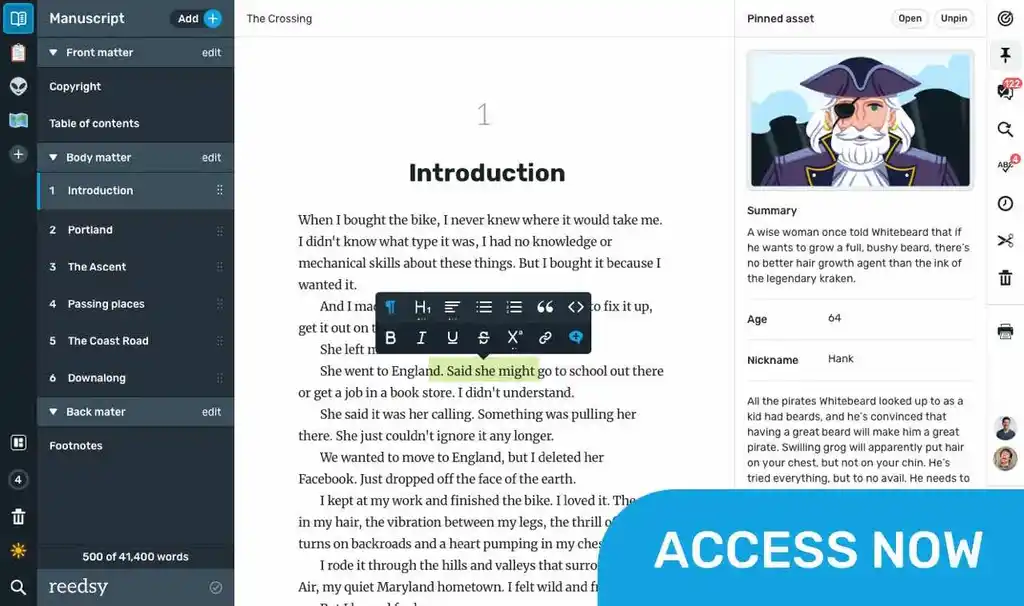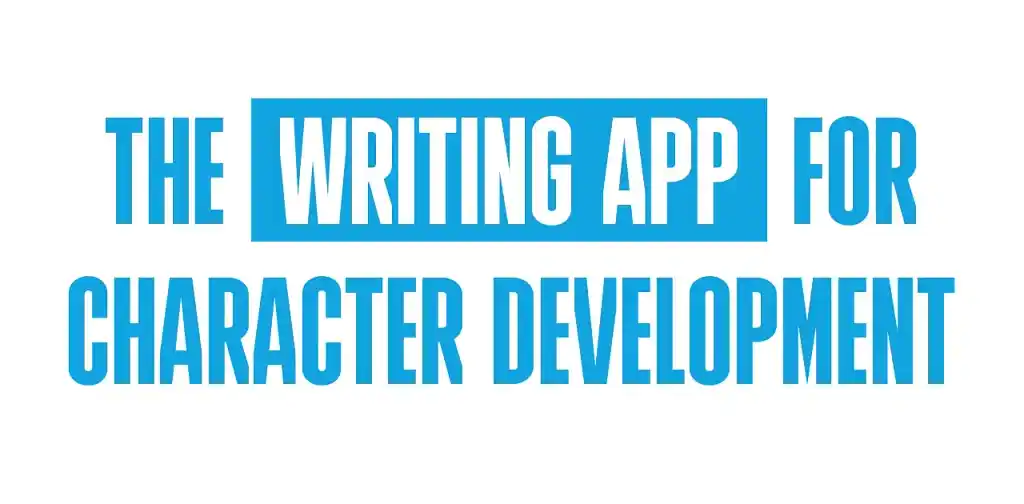Characterization describes the way a writer or actor creates or implies a character's personality, their inner life, and their psyche. The two main ways to flesh out your characters are direct characterization and indirect characterization.
In this article, we’ll take a close look at these two characterization techniques, using illustrative examples from popular books and classics. We’ll also be giving some practical advice on how you can apply them effectively to your own writing, so let’s dive right in.
What is direct characterization?
Direct characterization means that the author explicitly tells the reader a character's personality or traits.
For example, an author might explicitly tell the reader that a character is kind, funny, eccentric — or a terrific liar, as with Holden Caulfield — and so forth, using a lot of descriptive adjectives and exposition.
Let’s look at an example of this in action.
Direct characterization examples
To the Lighthouse by Virginia Woolf
Here's an example of direct characterization from Virginia Woolf's To the Lighthouse (1925) where Woolf explicitly shows what characters think of one another.
Looking up, there he was - Mr. Ramsay - advancing towards them, swinging, careless, oblivious, remote. A bit of a hypocrite? she repeated. Oh no - the most sincere of men, the truest (here he was), the best; but, looking down, she thought, he is absorbed in himself, he is tyrannical, he is unjust…
— Virginia Woolf, To The Lighthouse (1927), p. 52.
In this example, an artist staying with the Ramsay family, Lily Briscoe, is thinking about Mr Ramsay — whom another character, Mr Bankes, has just called a hypocrite.
This is direct characterization: through Lily’s thoughts and memory of Mr Bankes’ description, Woolf describes Mr. Ramsay's traits directly: sincere and true, but unjust. Through Lily, we also learn Ramsay is 'absorbed in himself' or self-absorbed and tyrannical. These direct statements about Ramsay's personality help us picture him and how he comes across to others.
To Kill a Mockingbird by Harper Lee
In this modern classic, the child narrator Scout describes her father, Atticus Finch, using direct characterization:
Atticus was feeble: he was nearly fifty. When Jem and I asked him why he was so old, he said he got started late, which we felt reflected upon his abilities and manliness.
— Harper Lee, To Kill a Mockingbird (1960) p.116.
There’s no escaping it; in the eyes of these children, Atticus looks old and feeble.
Normal People by Sally Rooney
Another, more contemporary example of direct characterization can be found towards the end of Sally Rooney’s novel Normal People (2018). In this scene, Connell (the male protagonist) thinks about Marianne (the female protagonist), who has endured both emotional and physical abuse throughout her life:
She’s missing some primal instinct, self-defence or self-preservation, which makes other human beings comprehensible. You lean in expecting resistance, and everything just falls away in front of you.
— Sally Rooney, Normal People (2018) p. 247
Here, Connell is describing someone who is quite fragile, who has been broken down by the experiences they’ve had in life and who lacks the self-preservation that most other people have. Through Connell’s direct description, we get a better understanding of who Marianne is, in the eyes of someone who knows her well.
So what about indirect characterization?
What is indirect characterization?
'Indirect characterization' shows readers your characters' traits without explicitly describing or naming them.
To give simple examples of direct vs indirect characterization, the former might be written as such: 'Jessica was a goofy, eccentric teacher'.
But for indirect revelation of Jessica's character, you might instead write: 'Jessica had named the stick with a hook on the end she used to open the classroom's high windows Belinda, and would regale her students with stories of Belinda's adventures (even though they were fourteen, not four)’.
In the second example of characterization (the indirect kind), it is implied that Jessica is goofy and eccentric. Despite being an adult herself, she names inanimate objects and tells teenagers stories of make-believe that would probably be better suited to younger children.
Types of indirect characterization
While direct characterization is pretty, well, direct, there are multiple ways you can go about characterizing people indirectly. So what types of indirect characterization are there?
Any writing that helps us infer or deduce things about a person's psyche, emotions, values or mannerisms can serve as indirect characterization. For example:
- Dialogue-based inference: From the way your character speaks and how they interact with others in the story, your reader may deduce that they are kind, cruel, gentle, shy etc.
- Implying through action: What your character does (for example jumping on a beetle to squash it) implies their character (in this case, it may imply that a character is cruel).
- Description of inner thoughts: By following a character's inner monologue about themselves, events in the novel, or other characters, we can infer things about their personality. For instance, they may think derogatory things about another character but act nice to their face, implying that they are disingenuous.
Let’s now look at some real examples of indirect characterization in literature.
Indirect characterization examples
The Grapes of Wrath by John Steinbeck
In The Grapes of Wrath (1939), John Steinbeck shows rather than tells Joad’s personality indirectly throughout the novel.
That is, he doesn't simply state that Joad is a down-and-out, blue-collar worker. Instead, Steinbeck indirectly characterizes Joad through the items he carries (whiskey, cigarettes), his physical presentation (calloused hands), and his manners (rubbing the cigarette butt to a pulp and throwing it out the window):
Joad took a quick drink from the flask. He dragged the last smoke from his raveling cigarette and then, with callused thumb and forefinger, crushed out the glowing end. He rubbed the butt to a pulp and put it out the window, letting the breeze suck it from his fingers.
— John Steinbeck, The Grapes of Wrath (1939), p. 9.
Here, from the context of the novel, the reader can infer that Joad belongs to the humbler echelons of society.
The Road by Cormac McCarthy
In this modern classic, Cormac McCarthy captures the nameless father figure by allowing the reader to see the world through his eyes:
He watched the boy and he looked out through the trees toward the road. This was not a safe place. They could be seen from the road now, it was day. The boy sat tottering in the blankets, the man watched him. He lay listening to the water drip in the woods. Bedrock this. The cold and the silence. The ashes of the late world carried on the bleak and temporal winds to and fro in the void. Carrying the fire.
— Cormac McCarthy, The Road (2006) p.5
Though this passage contains no straightforward description of either the boy or the father, the father’s worry about their location and awareness of danger creates a sense of vigilance, savvy, and protectiveness.
Normal People by Sally Rooney
Similarly, Rooney describes Marianne indirectly in another section of Normal People:
Marianne had the sense that her real life was happening somewhere very far away, happening without her, and she didn’t know if she would ever find out where it was and become part of it. She had that feeling in school often, but it wasn’t accompanied by any specific images of what the real life might look or feel like. All she knew was that when it started, she wouldn’t need to imagine it anymore.
— Sally Rooney, Normal People (2018) p.11
Without explicitly telling us, we instinctively know that Marianne is a bit of a dreamer and that she feels like an outsider in her community. Rooney also creates an air of melancholy and disenchantment that the reader will associate with Marianne throughout the book.
As shown by these examples, indirect characterization invites your reader to deduce things about your characters without explicitly telling them who they are. It relies on subtext. However, note that most novels — Normal People being one of them — contain a combination of direct and indirect characterization — providing a satisfying balance of both immediate understanding and subtler inference for readers.

Now, how do you use direct and indirect characterization well? Read these 8 tips below (and our complete guide to description for more examples).
8 tips for using direct and indirect characterization
Now that you have a better idea of what direct and indirect characterization is, let’s look at how you can apply it to your own writing:
1. Avoid overusing direct characterization
Direct characterization is useful shorthand. Instead of pages showing how a character is mean, you could start with 'He was mean.' Balance is key, though. Overusing direct characterizing may skew the balance towards telling, not showing.
If, for example, you wrote, 'He was petty and generally unkind, so that neighbors crossed the street when he passed,' that mixes some indirect characterization with the direct type. Neighbors crossing the street is a visual that indirectly implies avoidance and discomfort or possible dislike.
If you were to only tell readers about your characters' traits without weaving in illustrative showing, the effect would be:
- Hazy visuals: Crossing the street in the example above gives a more specific visual than simply saying 'he was disliked by the community'.
- Lack of depth and color: If you exclusively “tell” your reader who your characters are — with minimal showing or inferring — it can read as though you are simply summarizing them, rather than showing a fuller, more detailed picture of who they are.
Example of blending direct and indirect character detail
Beloved by Toni Morrison
The opening of Toni Morrison's powerful novel Beloved characterizes a house that is haunted by the ghost of an infant. Note how Morrison moves from the direct characterization of the first sentence to specific, visual details in the rest of the quote:
124 was spiteful. Full of a baby's venom. The women in the house knew it and so did the children. For years each put up with the spite in his own way, but by 1873 Sethe and her daughter Denver were its only victims. The grandmother, Baby Suggs, was dead, and the sons, Howard and Buglar, had run away by the time they were thirteen years old - as soon as merely looking in a mirror shattered it (that was the signal for Buglar); as soon as two tiny hand prints appeared in the cake (that was it for Howard).
—Toni Morrison, Beloved (1987), p. 17.
By referring to the victims of the house, Morrison is depicting it as something beyond spiteful; a place where you will find yourself in danger, or which will run you out, like Howard and Burglar. Blending direct and indirect descriptions like this makes the writing dynamic and more engaging to the reader.
2. Be direct with key details
The trick to effective direct characterization is to reserve it for key details you want to establish upfront.
In the example of blending indirect and direct character description from Beloved, Morrison starts with direct, broad detail. A sense of spite that drives boys in the family from a home filled with the ghosts of a corrosive, violent history.
Example of using direct characterization for key details
Pride and Prejudice by Jane Austen
In the opening scenes of Pride and Prejudice, we are first introduced to the beloved character of Elizabeth Bennet through a conversation between Mr. and Mrs. Bennet, when the former described his second eldest daughter as having “something more of quickness than her sisters,” referring to her intelligence and wit. A bit later on, we also get to see Elizabeth through the eyes of Mr. Darcy, when he utters the famous line: “She is tolerable, but not handsome enough to tempt me.”
All in all, these first few glimpses of Elizabeth Bennet establish that she is a character that may not possess conventional beauty, but whose sharp mind sets her apart from others. This is later expanded upon by both direct and indirect characterization in the scenes that follow, but by offering these initial direct characterizations, Austen is able to get all her readers on board with the central premise of the novel from the get-go.
To know what key details to highlight in this way to make your own characters come to life, it helps knowing them inside out.
Learn to write characters that readers will love
10 free lessons on character development
3. Support character statements with scenes
Just like you would need to back up your claim or hypothesis in an essay with proof, readers expect you to provide supporting facts for direct characterization — and this is best done by creating vivid imagery in your scenes. The example from Beloved shows how you can use indirect characterization to support direct descriptive statements.
Take the boys, Howard and Buglar, fleeing from mirrors that seem to shatter by themselves or tiny hand prints appearing in a cake, for example. These specific images and incidents support the suggestion that the home at 124 is haunted by a 'spiteful' (or rather, determined-to-be-known) presence.
So if you initially tell readers that a character is kind, think about how you can use both fleeting moments and more dedicated scenes to support this. This is what the story structure ‘Save the Cat’ is based on: the idea is that if you start with a scene where your character performs a good deed, like saving a cat from a burning building, your readers will know that they are a good, kind person who they are supposed to root for.
Maybe your character gives up a seat on public transport for an elderly person. Maybe they help a neighbor rescue a pet that has run into a busy road. Or maybe they shovel their neighbor’s driveway when it snows without even being asked.
Indirect characterization like this is useful because it shows your reader the type of actions your character is likely to take. In turn, this enables your reader to make educated, qualified guesses about how your characters might react in situations whose outcome is not yet known. Through this, one 'gets to know' characters as though they were real people — not to mention keeps readers on the hook to see if their predictions will be right.

4. Imply character through action and reaction
Action and reaction also provide useful ways to tell your reader who your characters are indirectly.
For example, let’s say a character has a vase that belonged to her grandmother — a family heirloom she cherishes — and her hyperactive son knocks it over and breaks it. Does she scold him to be careful? Lash out? Show a mix of anger and understanding?
Think about what you want your reader to infer about a character from the way they react, even in incidents or situations that are trivial or secondary to your story's main plotline. In this way every scene, every incident, will contribute toward building your characters' personae.
5. Use direct details to be concise
At this point, you might think that direct characterization is lazy, poor writing, while indirect characterization is more elevated — but the truth is that they both serve important purposes. One of the benefits of direct characterization is that it allows you to be concise when you need to be.
Direct characterization is useful, for example, when a narrator is recapping prior events that are relevant to the present story but not its main focus, and/or to establish the basics of a character early in a novel (which you can expand upon later).
On the first page of Nick Hornby's Slam, a novel about a sixteen-year-old skater named Sam, Hornby writes:
So things were ticking along quite nicely. In fact, I'd say that good stuff had been happening pretty solidly for about six months.
- For example: Mum got rid of Steve, her rubbish boyfriend.
- For example: Mrs Gillet, my art and design teacher, took me to one side after a lesson and asked whether I'd thought of doing art at college.—Nick Hornby, Slam (2007), p.41
At this point in the story, the reader doesn't need a lengthy exposition about why Steve was a rubbish boyfriend. The reader is already in agreement, implicitly trusting the narrator’s candid tone. Direct characterization of Steve suits the purpose of this part of the story: catching the reader up on what has been happening in the teenaged protagonist's life.
There is still a balance between indirect and direct characterization in this example. Sam’s second example implies to us, through Mrs Gillet's action, that the teacher is caring and sees artistic potential in Sam.
6. Characterize indirectly through dialogue
Dialogue is a fantastic device for characterization because it may move the story forward while also showing your reader who characters are in a subliminal way.
If, for example, there is banter and characters tease each other, it implies an ease and familiarity (compared to stiff formality between strangers). If, on the other hand, someone speaks in stumbling, run-on sentences, it might imply that they are shy or unsure of themselves.
Note, for example, how Hornby creates a sense of how awkward Rabbit (an 18-year-old skater at Grind City, a skate park Sam frequents) is in the dialogue below:
'Yo, Sam,' he said.
Did I tell you that my name is Sam? Well, now you know.
'All right?'
'How's it going, man?'
'OK.'
'Right. Hey, Sam. I know what I was gonna ask you. You know your mum?'
See what I mean about Rabbit being thick? Yes, I told him. I knew my mum.—Nick Hornby, Slam ( 2007) pp.11-12.
In this brief exchange, we see through the awkward, stop-start flow of conversation how Rabbit lacks social graces and awareness and (in the ensuing dialogue) reveals he has a crush on Sam's mother.
7. Let narrative voice lend character
Another useful way to use indirect characterization is to give an involved narrator (i.e., a narrator who is also a character in the story) a personality-filled voice.
In the above example of characterization via dialogue, for example, Sam makes an aside to the reader ('Well, now you know' and 'See what I mean about Rabbit being thick?'), which creates the sense of a streetwise, slightly jaded teenaged voice.
Think of similar ways you can inject characters' personalities into their narration. What subjects do they obsess over? (For example, it's clear Sam loves skating from the first few pages of Slam.) How do they see others? (Sam appears dismissive and a little cocky, from referring to his mom's 'rubbish' boyfriend to his description of Rabbit as 'thick'.)
Depending on the POV of your narration — close third person perspective or first person perspective, for instance — you can use language your character would use based on demographic details such as age, cultural background, or class identity.
Case in point: the casual, clipped language Sam uses in the example above suggests the 'too cool for school' attitude of a teenaged boy.
8. Read more examples of direct and indirect characterization
To really understand the uses of direct and indirect characterization — and how to blend the two to show and tell, describe and imply — look for even more examples in books!
You could even write out the descriptions you love, noting down what is direct, what is indirect, and what the effect is to create your own reference guide for character development.
And there you have it. Hopefully, this breakdown will help you create your own believable, well-developed characters. Writing a book is easier when you understand the tools at your disposal, and it will only make your reading more enjoyable too!












Well explained and helpful
Lexi Pivovarova - Over 8 years ago
Thank you, Lexi. Thanks for reading!
Bridget At Now Novel - Over 8 years ago
Thanks for this, I've been back a few times now but failed to post a comment. ? This is going to help a lot during this revision!
Robin T Vale - About 8 years ago
It's a pleasure, Robin. Glad you managed in the end. We've been migrating our blog to https (more secure) which may have been the cause. Good luck with your revision!
Bridget At Now Novel - About 8 years ago
Ah! Okay. Thank you! First books are hard so much to learn. I feel like I could have written two other books while fixings this one. xD (I want to, I enjoy shaping the old chapters to how I write now. ^;^) I also found a program to help speed this up; bibisco. I like it way more than the complicated expensive writing programs out there. IMO. Where to sign up to get updates for this blog? I don't want to forget about your blog. (I need reminders for everything. lol. A newsletter is a good way to do that.)
Robin T Vale - About 8 years ago
Hi Robin, If you sign up for a Now Novel member account, you get subscribed to our blog newsletter too. Alternatively, drop us a line at help at now novel dot com with the email address you'd like to use to get updates and I'll have our email guy add you to our mailing list. Thanks!
Bridget At Now Novel - About 8 years ago
Can you please ,include a section about dynamic and static characters? Thanks for your precious help
Abdou Djedei - About 8 years ago
Hi Abdou, thank you for the suggestion! I'll add it to the list for revision ideas, thank you.
Bridget At Now Novel - Over 7 years ago
You are welcome.
Abdou Djedei - Over 7 years ago
This is such a great website offering very useful tools for writers. I've been Googling for days now about everything I wanted to learn in novel writing and I can't believe I just found this site.
Alexa Marsh - About 7 years ago
Thanks, Alexa. I'm glad you've found our website helpful :)
Jordan At Now Novel - Almost 7 years ago
You shared some excellent tips on characterization. I think all writers can benefit from this blog.
Derrick - Almost 6 years ago
Thank you so much, Derrick. I'm glad you're finding our blog helpful! Thanks for reading.
Jordan At Now Novel - Almost 6 years ago
This is very helpful and I Aced my quiz on something i'm not that good at cool when you lookat the paper it looks long but when you start reading you get lost
Kimberly - About 5 years ago
Glad you aced your quiz, Kimberly.
Jordan - About 5 years ago
Thank You great job!
Anna - About 5 years ago
Thanks, Anna. Thank you for reading our blog!
Jordan - About 5 years ago
Very useful. Thank you so much,
Aleix - Almost 5 years ago
Thank you for your feedback, Aleix. It's a pleasure, thank you for reading our articles.
Jordan - Almost 5 years ago
Thank you for a clear explanation. It is most useful.
Vivienne - Over 3 years ago
It's a pleasure, Vivienne. Thank you for reading our blog.
Jordan - Over 3 years ago
An author employs indirect characterization to avoid explicitly announcing a character's attributes by revealing those aspects to the reader through the character's actions, thoughts, and words. Using the phrase "John had a short fuse" as an example would be direct characterisation, but the phrase "John hissed at the man without any prior warning" would be indirect portrayal.
Blog King - Over 3 years ago
Thank you for sharing your example of indirect and direct characterization and for reading our blog.
Jordan - Over 3 years ago
Thank you for providing this complete reference on direct and indirect characterization. It is often difficult to strike a balance between showing and explaining in writing, and your examples and advice are quite helpful. I really like the focus on utilizing both strategies sparingly, as well as the reminder that indirect characterization may frequently result in a more detailed and compelling picture of characters. I'll keep these tips in mind as I strive to hone my own writing style.
Exotic Wood Zone - Almost 2 years ago
Thanks so very for your comment. We're so pleased that you found it helpful. All the best with your writing!
Arja Salafranca - Almost 2 years ago